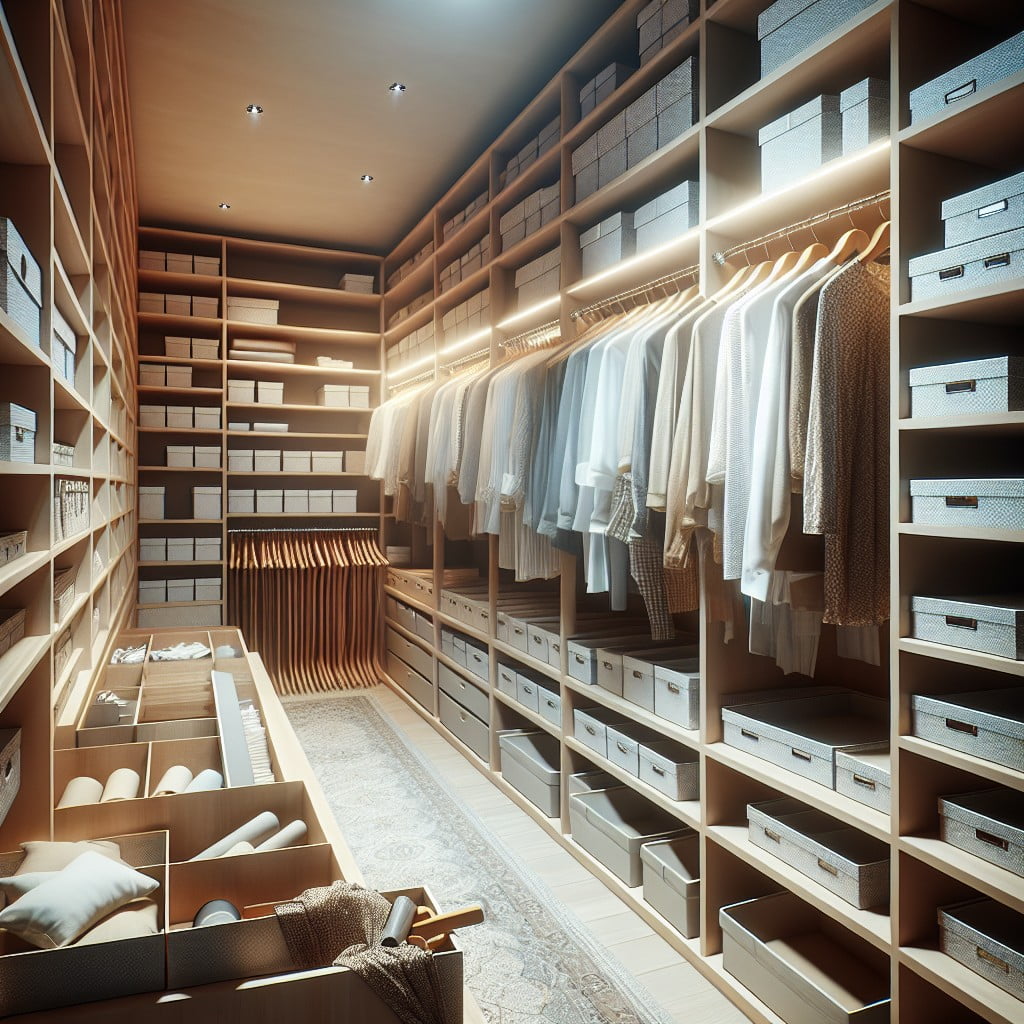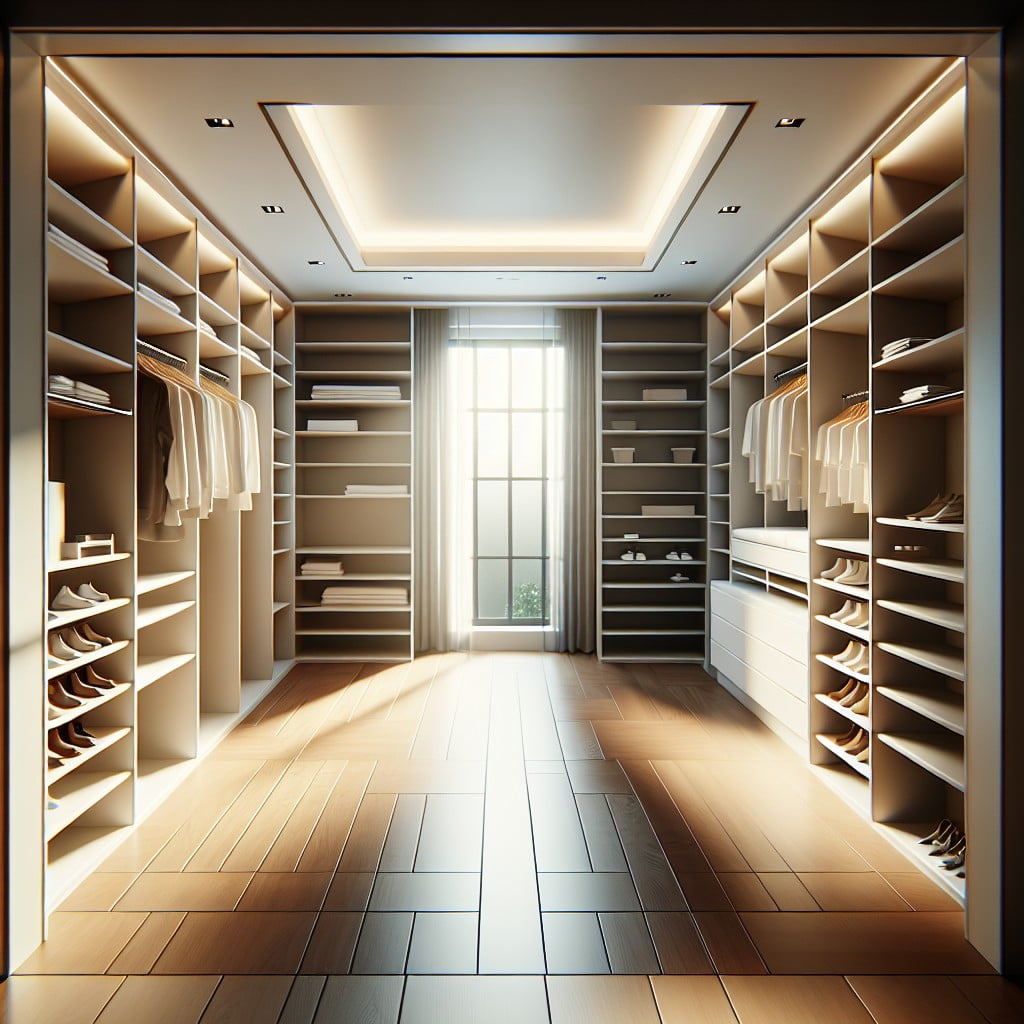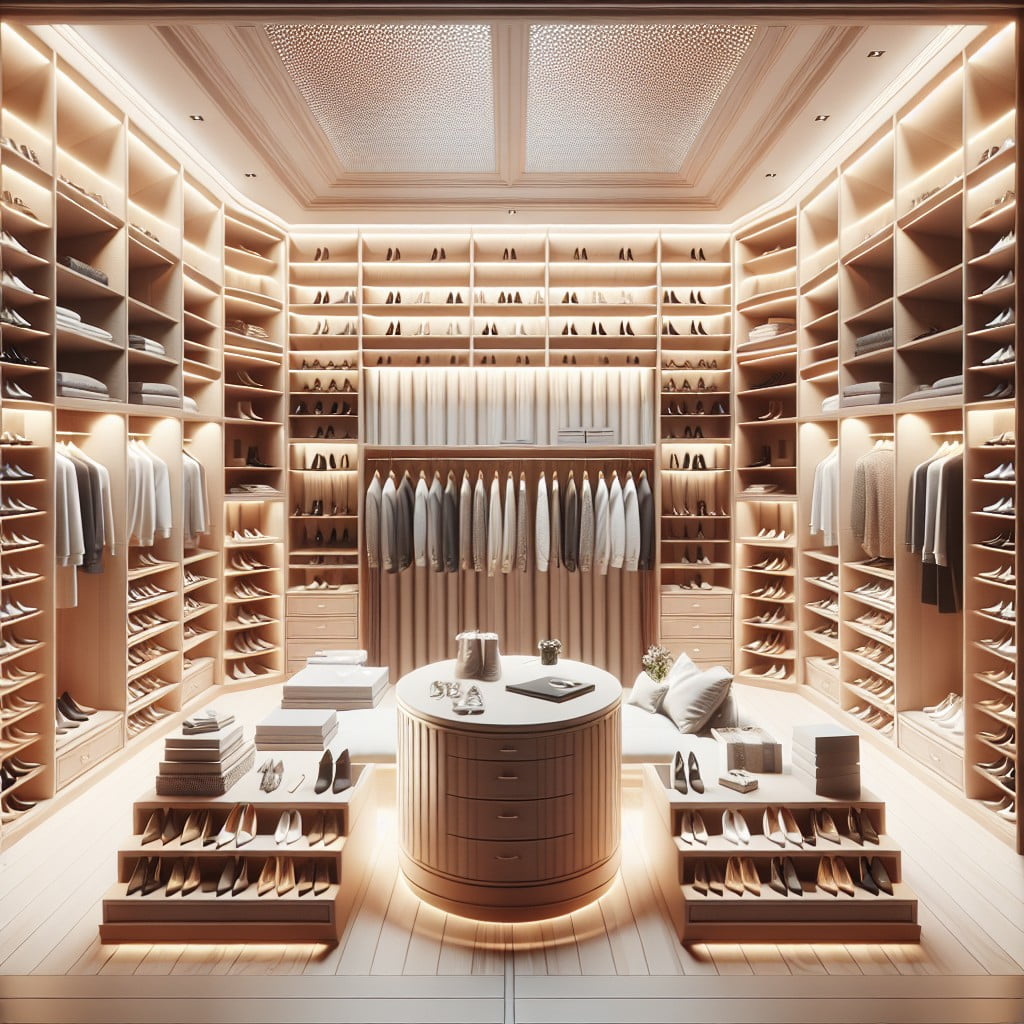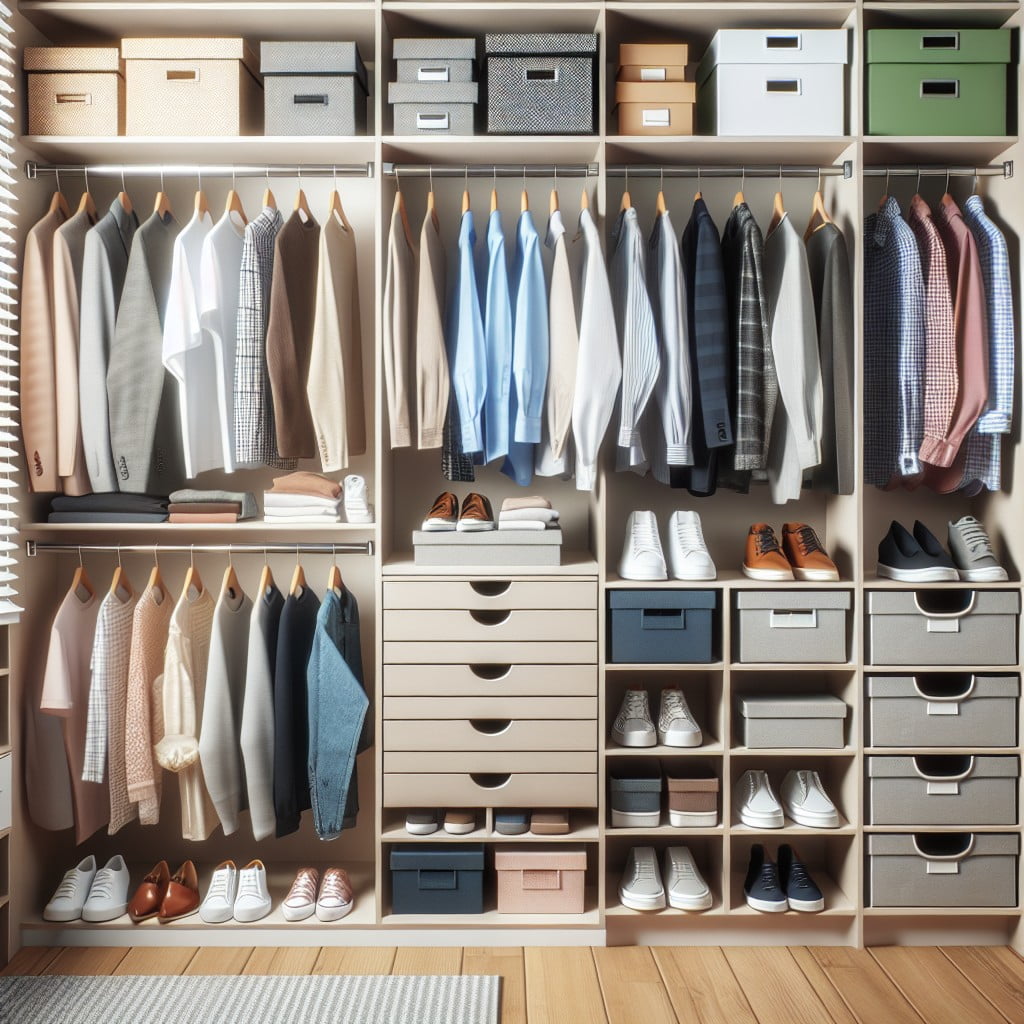Last updated on
Mastering the organization of a walk-in closet can prove transformative for your daily routine because an organized space promotes efficiency and time-saving strategies.
Key takeaways:
- Empty the closet and categorize items
- Clean the closet thoroughly before organizing
- Consider enhancements like shelves and hooks
- Sort items by season and purpose for easy access
- Utilize a closet system that maximizes space and organization
Empty the Closet

Start by removing all items from your walk-in closet, including clothes, shoes, and accessories. This initial step allows you to take stock of everything you own and identifies items that no longer serve you.
Create distinct piles as you go: one for keep, one for donate, one for repair, and one for discard. Temporarily relocate these piles to a different area to keep your workspace clear.
This process not only declutters your space but also simplifies the task of reorganizing and determining what storage solutions will be needed. Remember to handle each item only once to maximize efficiency during this phase.
Clean the Closet

Before adding any organizational systems to your walk-in closet, start with a thorough cleaning. This sets the foundation for a well-maintained space.
Wipe down shelves, sweep or vacuum the floor, and clean the baseboards to remove dust and dirt. If your closet has any windows or mirrors, give them a shine too.
This is also the ideal time to paint the walls if you’re considering a fresh color or to add any additional hooks or hardware that will aid in organization.
A clean slate allows you to imagine new layout possibilities without being hindered by clutter or grime.
Remember to let the space fully dry and air out if you’ve used any cleaning products that may leave a scent or residue.
Consider Enhancements

Before restocking your closet, think about possible improvements to the current setup:
- Install additional shelves or drawers for increased storage options.
- Add hooks or rods for belts, ties, and scarves.
- Opt for sliding baskets for smaller items like socks and undergarments.
- Consider a built-in or freestanding dresser if space permits.
- Look into back-of-door storage solutions for maximizing space.
- Update closet rods with durable, high-quality materials that can handle the weight of your clothes.
- Incorporate dividers to keep stacks of folded clothes neat.
- Think about adding a small bench or seat for comfort while dressing.
Sort the Closet Items

Approach the sorting process by categorizing your possessions to make it easier to find and access items later. Begin by separating your clothing by season – cold weather apparel like coats and sweaters should be distinct from summer dresses and shorts. Next, differentiate your attire by purpose: work, casual, formal, and workout clothes. This will streamline your decision-making process when choosing an outfit.
Once the clothing is categorized, tackle the smaller items. Divide accessories like belts, scarves, and jewelry, keeping like with like to simplify locating the perfect piece to complement your outfit. Apply a similar sorting strategy to other items, such as bags and hats.
Embrace the opportunity to purge as you sort. Set aside any items you haven’t worn in the past year or no longer fit to donate or sell. This not only clears space but also makes your closet more functional by ensuring that everything within it is something you’ll actually use.
Organize the Closet
When sorting through items, group like with like to create a sense of order and ease of access. For example, place all trousers together, hang shirts by sleeve length, and designate a specific area for seasonal clothing. Implementing a color-coding system within each category not only enhances the aesthetic but also allows for quick outfit selections.
Invest in quality hangers to maintain the shape of garments and give the closet a uniform look. Different types can be used for pants, skirts, and delicate items to ensure proper care. For folded items, stack them neatly on shelves, not too high to avoid toppling piles. Use shelf dividers to keep them upright and organized.
Maximize vertical space by installing hooks or pegs for belts, scarves, or bags and consider clear, labeled bins for lesser-used items on higher shelves. This will streamline the search process and keep the closet tidy. Remember to allocate a section for everyday essentials at eye level for convenience.
Choose a Closet System
Selecting an appropriate closet system is pivotal in maximizing space and maintaining organization. When making this choice, consider the following:
- Modularity: Opt for systems that allow for interchangeable shelves, drawers, and rods. This flexibility lets you customize the setup to fit your wardrobe and can be easily adjusted as your storage needs change.
- Material: Durability is key. Wooden systems add elegance but might be pricier. Wire and laminated kits are budget-friendly and practical, offering good ventilation for clothes.
- Design: Keep in mind the dimensions of your walk-in closet. A well-designed system will make use of vertical space and corners, areas often underutilized.
- Ease of Installation: Assess if the system can be self-installed or if professional help is required. Some systems offer simple clip-and-lock features, while others may necessitate tools and hardware.
- Visibility: Prioritize systems that keep items in clear view, to avoid having to search for things. Open shelving or glass-fronted drawers can make identifying contents straightforward.
Make a judicious choice that blends practicality with aesthetics to create a system that not only caters to your storage needs but also complements your personal style.
Utilize a Hamper
Incorporating a hamper into your walk-in closet design helps to keep dirty laundry separate and your space clutter-free. Opt for a hamper that fits comfortably within the closet without obstructing walkways or access to clothing.
Consider these points to optimize your hamper usage:
- Select a hamper with divided sections for lights, darks, and delicates to streamline your laundry process.
- Choose a hamper with a lid to contain odors and maintain a neat appearance.
- If space permits, a roll-out hamper integrated into your closet system can be a discreet and convenient option.
- For smaller closets, collapsible hampers save space when not in use.
- If aesthetics are important, look for hampers that match your closet’s color scheme or material.
Remember, the goal is to have a functional hamper system that complements your closet organization and simplifies your routine.
Efficiently Store Shoes
When it comes to shoe storage, maximizing space while maintaining easy access is key.
Use clear shoe boxes or drop-front containers to stack your shoes vertically, saving floor space and keeping them dust-free.
Over-the-door shoe organizers are perfect for flats and smaller footwear.
For a more visually appealing setup, consider a shoe rack or custom-built shelves to showcase your collection.
Remember to keep frequently worn pairs within easy reach and to group shoes by type or season.
Utilizing designated spaces for boots and taller items prevents them from cluttering the floor.
If possible, include a small seating area to make trying on shoes more convenient.
Remember, the goal is to create a system that is both practical and visually pleasing.
Plan for Accessories
Accessories are prone to becoming cluttered if not stored properly. To keep items like jewelry, belts, ties, and scarves organized:
- Use drawer dividers for smaller items like watches and jewelry to keep them separate and easy to find.
- Install hooks or pegs on the back of the closet door or on a wall for hanging items like necklaces, which helps to prevent tangling.
- Consider a tie and belt rack that can either be mounted or hung over a door, allowing for easy access and visibility.
- Foldable storage cubes or bins work well for stowing scarves or hats on shelves to keep them dust-free and maintain their shape.
- For sunglasses and other small accessories, a shallow tray can provide an organized home that’s easily accessible on a shelf or dresser within the closet.
Add Closet Lighting
Illuminating your closet transforms the space, making it easier to find and organize your belongings. Consider these lighting options:
1. LED Strips: Adhesive LED strip lights are easy to install along shelves and beneath hanging rods for uniform brightness.
2. Puck Lights: These battery-operated or rechargeable lights can be placed under shelves or in dark corners and activated with a simple touch or remote control.
3. Recessed Fixtures: If you have a higher ceiling, consider recessed lighting for a sleek, out-of-the-way solution that floods the closet with light.
4. Track Lighting: Adjustable track lighting helps focus light on specific areas and can be repositioned as your closet layout changes.
5. Motion Sensors: Installing motion sensors ensures lights only come on when you need them, conserving energy and extending bulb life.
When selecting lighting, ensure it has a high color rendering index (CRI) for true color representation of your clothes and accessories. Always prioritize safety by opting for a certified electrician for any hardwired installations.
FAQ
How do you optimize a walk-in closet?
Optimization of a walk-in closet can be achieved by doubling your hanging space with dual rods, utilizing hanging shoe organizers for accessories, incorporating small bookcases for folded clothes, shoes, or purses, and, importantly, measuring your closet space prior to purchasing any storage systems or accessories to ensure they fit.
What are the essential elements to consider when designing a walk-in closet?
The essential elements to consider when designing a walk-in closet include assessing storage needs, proper lighting, utilizing vertical space, incorporating a seating area, and integrating functional and appropriate closet fixtures.
How can lighting and color choices impact the functionality and aesthetics of a walk-in closet?
Lighting and color choices significantly impact the functionality and aesthetics of a walk-in closet by contributing to visibility, mood enhancement, and the overall perception of space.
What are some creative storage solutions to maximize space in a walk-in closet?
Creative storage solutions to maximize space in a walk-in closet include utilizing vertical space with tiers or shelves, using stackable storage boxes, incorporating multi-purpose furniture like ottomans with storage, and utilizing door hooks and hangers.
Recap:




